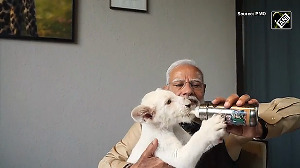Meet Lysinbacillus telephonicus, Microbacterium telephonicum, Pyrenochaeta telephoni.
Pallava Bagla reports from Pune.
Illustration: Dominic Xavier/Rediff.com

Scientists in Pune have identified three new species of microbes that flourished on mobile handsets.
How grimy are the ubiquitous mobile phones?
Reports from Western nations have suggested that mobile phones are more often dirtier than toilet seats, with some smart phones even known to harbour deadly drug resistant bacteria.
The startling finding is by scientists of the government-owned National Centre for Cell Science, Pune, who have been able to identify three new species of microbes from screens of mobile phones.
Two bacteria and fungus, never before reported in scientific literature, were identified by this laboratory funded by the Department of Biotechnology.
Earlier a study conducted in 2015 by William DePaolo, an assistant professor in the molecular microbiology and immunology department at the University of Southern California, found that toilet seats usually contained three different types of bacteria, but mobile phones on an average housed some 10 to 12 different types of fungi and bacteria.
Mobile phones -- since they are carried in almost all human environments from the kitchen to the public transport -- harbour a larger diversity of micro-organisms.
These microbes grow well on the sweat and grime left on the phones as humans carry them around.
In Pune, Yogesh S Shouche and his team from the Microbial Culture Collection group at the NCCS collected samples from 27 mobile phone screens and they were able to isolate 515 different bacterial types and 28 different fungi.
"These microbes are friendly to humans and usually thrive on our bodies," says Praveen Rahi, a co-investigator for the work.
The team used sterilised cotton swabs and sterile saline solution to wipe from the surface these microbes which were then grown using standardised culture media at 30 degrees centigrade.
What surprised this six-member team was that they encountered three new species of organisms -- two bacteria they have named Lysinbacillus telephonicus and Microbacterium telephonicum and a new species of fungi that they named Pyrenochaeta telephoni.
There is some good news, Rahi emphasises.
In the samples they collected none of the highly dangerously pathogenic microbes like Staphylococcus aureus, the most common multi-drug resistant super bug.
Yet he emphasises they did not actively sample smart phones used by health care workers where these super-bugs usually reside.
This Pune finding on the hygiene of mobile phones suggests that the situation is not as bad in India even though in this nation of 1.3 billion people there are more mobile phones than toilets.
On the other hand, a 2015 study from Alexandria in Egypt where more than half of the 40 samples collected from doctors at the university hospital harboured the super bugs.
Last week, the World Health Organisation gave out an alarming finding that 12 families of microbes were winning the war against antibiotics and humanity urgently needed to discover new chemicals to kill these super bugs.
'Antibiotic resistance is growing,' WHO said, 'and we are fast running out of treatment options.'
The simplest way to keep mobile phones clean and hygienic is not to carry them to toilets and to occasionally wipe them with semi-dry piece of cloth moistened with soap water and then fully drying the handset before putting it to use.
It is recommended that commercial cleaning fluids and sanitiser should not be used and that the mobile device should be switched off before any cleaning is attempted.
The NCCS group is known for their varied expertise on microbes as they house under one roof some 200,000 different microbe cultures, making it possibly the world's single largest microbe culture collection.
As they say mobile phones are literally mushrooming with India alone being home to some 900 million handsets yet who ever imagined that new species of organisms would be discovered from this 21st century electronic marvel.











 © 2025
© 2025